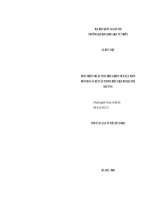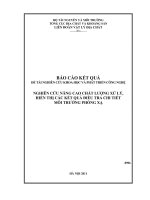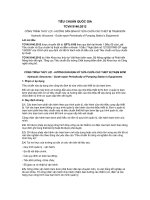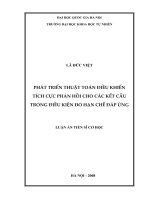SỮA CHỮA CÁC KẾT CẤU BỊ HƯ HỎNG DO MÔI TRƯỜNG BIỂN VÀ BỊ CÁCBÔNÁT HOÁ Ở PHÁP VÀ ÚC
Bạn đang xem bản rút gọn của tài liệu. Xem và tải ngay bản đầy đủ của tài liệu tại đây (15.1 MB, 11 trang )
Hội nghị khoa học tòan quốc lần thứ hai về
Sự cố và h hỏng công trình Xây dựng
REPAIR TO STRUCTURES DAMAGED BY MARINE
ENVIRONMENT AND CARBONATION IN
AUSTRALIA AND FRANCE
SữA CHữA các KếT CấU Bị HƯ HỏNG DO MÔI TRƯờng biển
và bị các-bô-nát hoá ở pháp và úc
Laurent Bouet
Civil Engineer. Technical Service Manager
Sika Limited Vietnam
ABSTRACT: Reinforced concrete has been widely chosen and used all
over the world for its both technical performances and
aesthetic properties.
But, concrete is a “living” material, that is subject to aggression
which are commonly the carbonation process and the chlorides and
sulfates attacks when these structures are exposed to marine
environment.
This paper present the repair concept of two projects where
concrete structures have been damaged by such attacks:
- Opera House-Sydney-Australia: Substructure repair work of this
famed project.
- Theatre Des Arts-Rouen-France: Facade repair work for which the
specific aspect of the concrete finish had to be maintained
Tãm tắt: Bê tông cốt thép đà đợc chọn và sử dụng rộng rÃi trên khắp
thế giới vì tính năng kỹ thuật cũng nh tính thẩm mỹ của chúng.
Nhng bê tông là một vật liệu sống và là đối tợng chịu sự tấn công
của quá trình cácbônát hoá và sự ăn mòn của clorua và sulfát khi
những kết cấu này tiếp xúc với môi trờng nớc biển.
Tài liệu này trình bày giải pháp sửa chữa của hai dự án nơi mà kết
cấu bê tông đà bị h hỏng do ăn mòn trên ở hai công trình:
- Nhà Hát Nhạc Kịch Sydney - úc: sửa chữa kết cấu hạ tầng cho dự
án nổi tiếng này.
- Nhà Hát Des Arts-Rouen-Pháp: sửa chữa mặt tiền mà vẫn giữ
nguyên diện mạo đặc thù của lớp bê tông hoàn thiện
1.Sydney Opera House Australia
Substructure repairing process.
Introduction
Reinforced Concrete had offered a lot of opportunities to architects
to express them self and achieve beautiful building which become
city or country landmark such as The Sydney Opera House (picture
1).
Danish Architect Jorn Utzon had designed a beautiful freestanding,
sculptural tripartite Opera House.
Sitting Bennelong Point, virtually in the Sydney Harbour, the Opera
House is completely exposed and overlooked by the great Sydney
Harbour Bridge.
Sydney Opera House construction
completed in 1973.
started in 1957 and was
The structure is made of cast in situ concrete, tile-clad concrete and
precast elements.
Due to its location, Sydney Opera House is subjected to both urban
and marine environment which have conducted the concrete
structure to present signs of deterioration less than 15 years after
the project was completed.
The part of the structure which has been suffering the most from
marine environment is the promenade substructure beams and
columns standing only less than 2 meters above sea level (picture
2).
Picture 2. Promenade
Substructure
Picture 1. General view of Sydney
Opera House
Substructure Repair program-Cause of damage
In 1991, a diagnosis of the structure concluded that the main cause
of the damages was the concrete carbonation process, low concrete
covers in some locations and of course the effect of chlorides onto
steel reinforcement.
Due to the reinforcement rust expansion, the concrete had started to
crack and consequently to spall.
The survey did not show that the visible cracks had a structural
origin.
Substructure Repair program-Repair Procedure.
Some repair works consisting of crack surface patching had been
previously applied but showed a poor durability.
Due to relatively large volume of the repairs, the solution of cast and
pour was chosen based on technical and practical considerations.
The approved repair work program of 1991 was as follows:
- Chipping off all cracked and spalled concrete making sure that allloose adhering material was removed. At the edge locations, right
angle cuts to concrete surface were provided to avoid feather edging
of repair material. The concrete was broken down all around the
reinforcement leaving a space of at least 10 mm in order to insure
proper mortar cover. (picture 3)
-
Reinforcements were prepared to eliminate any trace of rust.
- When required, additional rebars were put in place by welding of
splicing onto existing one.
- Corrosion inhibitor slurry, Sika Monotop 610 was brush applied to
the reinforcement.
-
A watertight wooden formwork was placed
- Non shrink grouting mortar called Sikagrout, was selected based
on its mechanical properties, non shrinkage behavior and to its
resistance to marine environment aggression due its silica fume
content that enhance overall durability and especially resistance to
sulfate.
- Sikagrout, once mixed with water using a slow speed electric
mixer, was then poured into the formwork in a continuous operation
(picture 4.)
-
Free face of grout was water cured.
- Thanks to Sikagrout early high strength development, the
formwork was removed as early as 24 hours after the grout being
poured.
- Finally, the repaired sections were wrapped in a plastic sheet, in
order to assure grout proper curing and therefore optimal grout
durability to be achieved (picture 5).
Picture 3. Surface Preparation
Sikagrout pouring
beam
Picture 5. View of repaired
Picture 4.
2.
Theatres Des
Technology
Arts-Rouen–France.
Repair
to
Original
Introduction
Numerous buildings have been built in west of France in 1950-1960
as part of the reconstruction program after the 2nd WWR.
Several architects, among them Le Corbusier, August Perret, Luigi
Nervi have been designing reinforced concrete structures (mainly
apartment and public buildings) with a non painted exposed
concrete finish surfaces (pictures 6 and 7).
Picture 6. Cast in place reinforced
micro concrete
concrete with exposed aggregates
exposed stones.
Picture 7. Precast
panels with large
But, a lot of these structures, today 40 to 50 years old, are now in
need to be refurbish in consequence to the following degradation
process:
Carbonation of concrete to depth up to 50mm
Marine environment exposure and chlorides penetration to
concrete in a
particularly rainy climate
Corrosion of reinforcement not anymore naturally protected by
alkaline concrete
Expansive rust creates cracks in concrete
Gaz (carbon dioxide), Water and Chlorides (rain) penetrates even
more and deeper accelerating the degradation process which
conduct to concrete spalling.
Theatres Des Arts of Rouen (picture 8) is among the numerous
building to receive refurbishment in France in a market estimated to
400 millions USD per year.
Built in 1960, Theatre Des Arts facades combine exposed aggregates
finish reinforced concrete and large pink marbles elements.
Picture 8. Theatres Des Arts-Rouen- France
Rouen’s Theatre Des Arts is typical of the post war architecture style
and therefore it has been registered as part of French Architecture
Heritage.
This meant that any refurbishment had to follow strict aesthetic and
technical rules that could meet the general requirement to “repair to
original”
A team composed of architects, contractors and Sika Company as
the repair material supplier was asked to develop a patented process
to refurbish that building with the goal of providing a solution to
meet both durability and aesthetic needs.
Rouen’s Theatre Des Arts was particularly damaged with numerous
concrete spalling
(pictures 9 and 10) and exposed corroded reinforcement. (picture
11)
Picture 9 & 10. Concrete spalling
Reinforcement corrosion
Picture 11.
The approved repair system was as follows:
Surface preparation by sandblasting and/or shipping cracked
spalled concrete.
(picture 12);
Application to exposed reinforcement of a ready to use 1
component corrosion inhibitor (picture 13);
Addition of new rebars (if required);
Patching of high performance ready to use repair mortar to
damaged areas. (High strength, impermeable Sikatop mortars)
(pictures 14 & 15);
Application on still fresh mortar of specially formulated
micro-concrete
repair
with pigments to match initial aspect (pictures 16 & 17);
Sponge finishing of still fresh micro concrete;
After drying and hardening of micro concrete and repair mortar, a
new sandblasting
is performed (picture 18);
Spray Application on all surface of Sika Ferrogard 903, penetrating
corrosion inhibitor to inhibit corrosion in areas where no damaged
is seen yet but where concrete is already carbonated. (picture 20)
Sika Ferrogard 903 is a multifunctional type of corrosion inhibitor
which interact with the steel reinforcement surface. It forms a
protective layer which act as a barrier for oxygen. It displaces
chlorides ions from steel surface but it does not modify concrete
performances and aspect. (picture 21);
Application of transparent concrete protective coated against CO2
penetration and acting as graffiti barrier.
Picture 12. Concrete chipping
610 corrosion
Picture 13. Sika Monotop
inhibitor applied to
reinforcement
Picture 14. Sikatop repair mortar application
Mortar applied
Picture 15.
Picture 17. Micro concrete
application to still
mortar
Picture 16. Micro concrete mixing
fresh Sikatop
Picture 18. micro concrete finishing
of hardened repair
Picture 19. Sandblasting
Picture 21. Action
mechanism of
Sika Ferrogard
903 to steel
Picture 20. Sika Ferrogard 903 ,
penetrating corrosion inhibitor
spray application
Picture 23. Theatres Des
Arts after
completion
Picture 22. Aspect of repaired
concrete surface
refurbishment
The satisfactory aspect of Theatres Des Arts facades (picture 22 &
23) after refurbishment completion has led to more repair program
of building with an exposed aggregates aspect.
3. Conclusion
Reinforced concrete can be affected by several attacks especially
carbonation phenomenon and chlorides attack (in a marine
environment) which often lead to corrosion of reinforcement and
consequently concrete cracking and spalling.
Repair techniques which can combine technical and aesthetic
requirements do exist but still need a good cooperation and team
work between the actors involved in that process including
contractor/applicator, architect and material supplier.
A good analysis of degradation causes, a proper selection of repair
solution combined with their proper application shall lead to optimal
repair durability and together aesthetic requirement./.









